Great Destinations in France: A World of New Adventure in Alsace
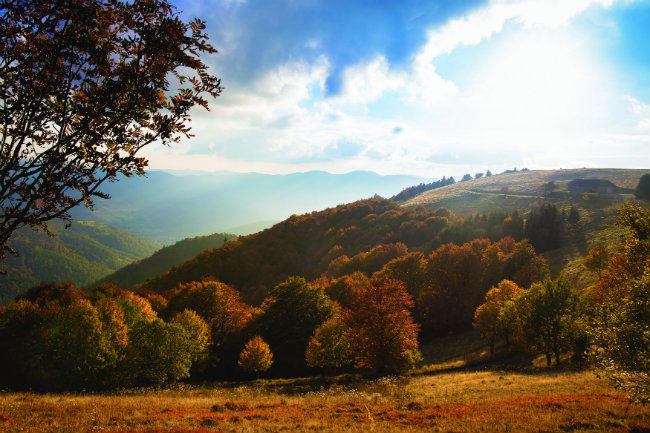
It’s a part of France that is unlike any other (not least because it hasn’t always been a part of France.) Much of the culture is distinctly German, and the influence of the Swiss is here too. Jeffrey T Iverson believes that however well you think you know France, until you’ve come to know Alsace, you ain’t seen nothing yet.
On a clear day in 1681, France’s Louis XIV was travelling to the eastern reaches of his kingdom when he finally came over the lip of the Vosges mountains, and for the first time, beheld the vast, fertile valley below. Spread before him was an ocean of verdant vineyards, fields of hops and grain, vast orchards, forest-covered hills topped by crumbling medieval castles, and proud, fortified villages. Struck by this bounteous vision, he exclaimed, “Ah, l’Alsace… quel beau jardin!”
What a beautiful garden indeed. Alsace, France’s eastern-most region, occupying the Rhine river plain, seems to have been almost preternaturally blessed in situation and climate. The Vosges mountains shelter Alsace from moist west winds, so much that the only place drier in France is Perpignan on the Spanish border. That makes the region extraordinary for many forms of agriculture, particularly winegrowing, the generous sunlight all but guaranteeing grape ripeness every season. In fact, for centuries, Alsace represented a kind of balmy Riviera for northern and eastern Europe, whose unquenchable thirst for Alsatian wine, sent up river by the barrel, earned many a fortune.
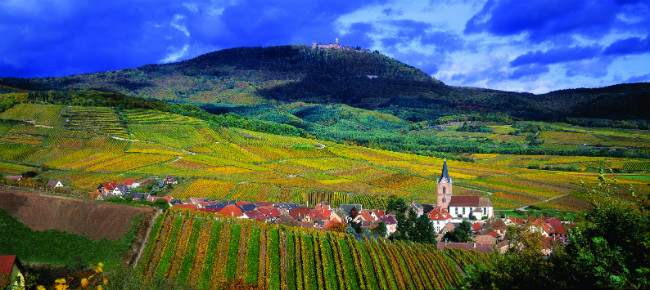
Rodern and Haut Koenigsbourg. Photo: CRTA/ Zvardon
With its fruitful lands and strategic location at the heart of Europe, Alsace was coveted and fought over for ages. Even Julius Caesar, during his military campaigns in 58 BC, named the region optimus totius Galliae – the best of all Gaul. In 1648, at the conclusion of the Thirty Years War, France annexed Alsace. But with each war that followed Germany disputed its control, such that Alsatians would change nationality four times between 1870 and 1945. The result of this tumultuous history was the development of a culture unique in the world. Alsace is profoundly French – it’s the birthplace of philosopher Jean-Paul Sartre, of Statue of Liberty designer Frédéric Auguste Bartholdi, and even of France’s national anthem, La Marseillaise, written in Strasbourg in 1792 – yet in many aspects of its language, gastronomy and character, it also reflects the cultures of neighbouring Germany and Switzerland. Truly, Alsace is the crossroads of Europe.
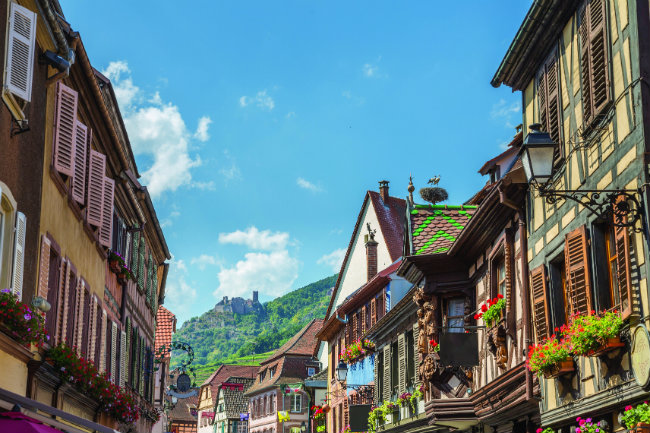
The beauty of Alsace. Photo: Fotolia
Today, it is in part this potent fusion of cultures that makes Alsace so alluring. For well-travelled Francophiles, visiting Alsace for the first time rekindles that sense of discovery and excitement – it’s France as you’ve never seen, or tasted, it. A France of baroque and classical buildings which testify to a rare combination of French and German architectural influences. A France of enchanting traditions like the atmospheric Christkindelsmärik, one of the oldest Christmas markets in Europe, held around the Strasbourg cathedral since 1570. It’s a France where everyday exchanges are still peppered with Alsatian words, even though French became the official language in the 1940s; where the villages have names like Pfaffenhoffen and Riquewhir; where you don’t order Sauvignon Blanc or Chardonnay, but Edelzwicker and Gewürztraminer; where you might take your tea with a piece of kougelhopf, or start a meal with a slice of presskopf.
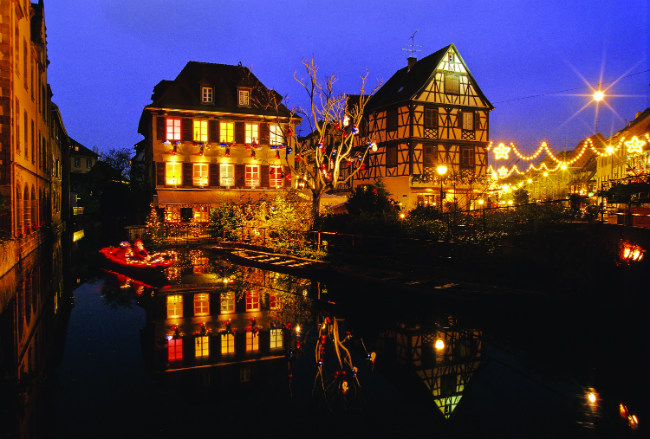
Colmar during the Christmas season. Photo: Conseil des vins d’Alsace
But the appeal of Alsace goes beyond its culture. Just 190km long and 50km wide, and comprising only two departments, Bas-Rhin in the north and Haut-Rhin in the south, Alsace is France’s smallest region, and also one of its wealthiest. Which means it has remained a region on a human scale, easy to explore, yet boasting a stunning variety of natural landscapes, a plethora of attractions, and beautifully-preserved heritage sites, all ready to be discovered. And there’s no better way to begin than with a voyage into the region’s ancient capital.
Until Louis XIV invaded in 1681, Strasbourg was for centuries an incredibly prosperous ‘Free Imperial City’, a hotbed of innovation and intellectual activity. Today, this rich past and spirit of independence is ever on display in the historic city centre, located on Strasbourg’s Grand Île, an island criss-crossed by elegant canals with half-timbered edifices built to the water’s edge. Standing at the heart of it all is what Victor Hugo called the “gigantic and delicate marvel” of the Strasbourg cathedral. At 142 metres (466 feet), it was the world’s tallest building for more than two centuries, and remains the tallest structure built in the Middle Ages. Full of mystery and wonder, the cathedral houses a giant astronomical clock, displaying the real position of the sun and moon, solar and lunar eclipses, and every day at half-past noon, a procession of 18-inch mechanical Jesus and Apostle figures. And twice a year, at the equinox in March and September, a green ray of light passes through a stained-glass window to illuminate a sculpted figure of Christ.
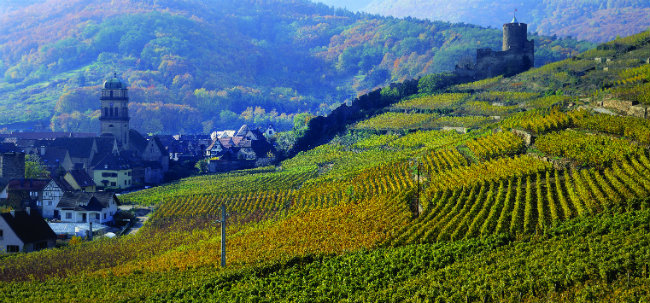
The village of Kaysersberg. Photo: CRTA/ Zvardon
Walking through the island’s Petit-France neighbourhood transports one into another era, when fishermen, millers and tanners lived in these grand 17th-century half-timbered houses, including some with striking overhanging upper storeys – features that continued to be built in Strasbourg years after they’d been banned in the rest of France. One may visit the historic cellar of the Strasbourg’s Hospice, built in 1395, which still preserves a barrel of wine from 1472, whose 300 litres constitute the world’s oldest wine in a barrel. The last person to sip this extraordinary cuvée was General Leclerc upon liberating the city in 1944.
Better to enjoy a recent vintage in an old restaurant, though, and none is older than the Kammerzell House, built in 1427 on the corner of the Cathedral Square. Every beam is covered in elaborate carvings depicting ancient scenes and characters like Caesar and Charlemagne. Their many choucroute recipes are among the most famous, and delicious, in the capital, with a wine list to match.
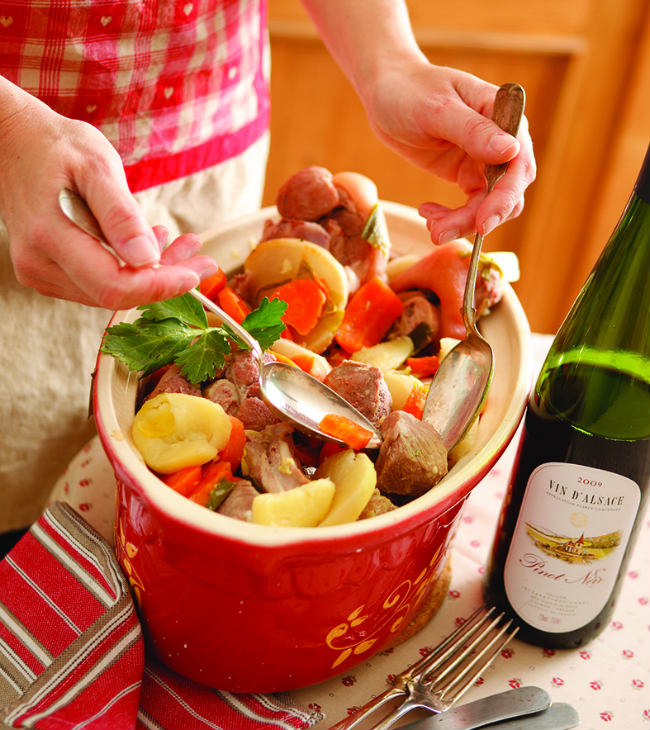
Baeckeoffe. Photo: ELPEV/ Conseil des Vins d’Alsace
Letting Alsatian wine be your guide is in fact a fine way to discover the region. The Route des Vins d’Alsace is a beautiful 170-kilometre wine route traversing the entirety of Alsace. From Marlenheim to Thann, it crosses one postcard-perfect landscape after another, past vineyard and mountain, ancient walled villages and Romanesque abbeys, ruined medieval castles and charming winstub wine bars.
Along the road between Strasbourg and Colmar, to view the crumbling stone towers that seem to occupy every strategic hilltop, one can’t help but gain a sense of the centuries of war which shaped the region. A visit to the Château du Haut-Koenigsbourg, with its unmatched view over the Alsatian plain reaching as far as the Black Forest, is a chance to immerse oneself in this fascinating history. First built in the 12th century, it was used, destroyed and rebuilt by successive powers from the Middle Ages until the Thirty Years War, when it was sacked by Protestant forces and abandoned. It wasn’t until 1899 that the Prussian emperor Wilhelm II restored the castle.
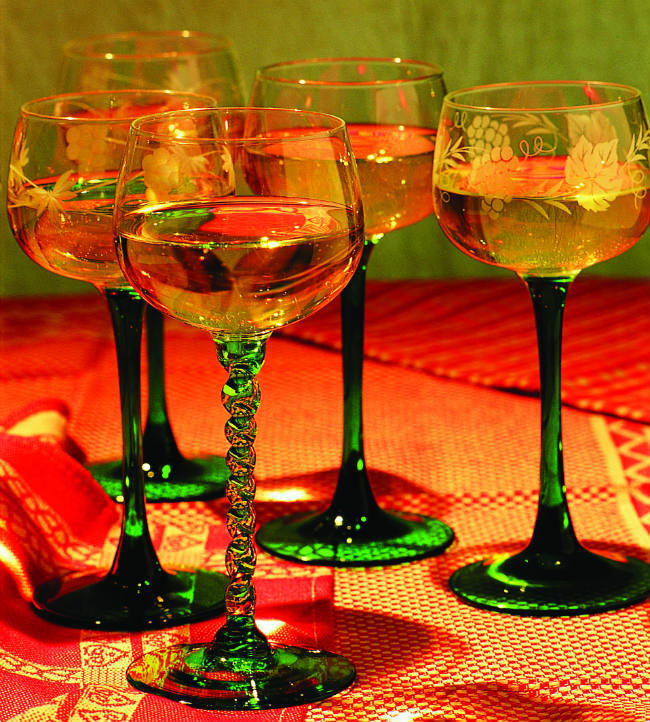
Traditional wine glasses in Alsace. Photo: Hampé
When one stops along the way at estates to enjoy a wine tasting and to speak with growers, it becomes clear that these historic conflicts have had ripples into the present. “Wine tastes different from different regions not just due to climate, geology and the grape varieties, but also cultural aspects,” says Olivier Humbrecht, France’s first Master of Wine and owner of the celebrated Domaine Zind-Humbrecht in Turckheim. “The fact that our history was so chaotic for so many years has also impacted the wines of Alsace.” Though recognised by experts as holding some of the world’s greatest terroirs, wars delayed Alsace from realising its full winemaking potential.
Only in 1983 did it introduce the Alsace grand cru appellation for wines, the kind of methodical vineyard categorisation that took place long before in Burgundy or Bordeaux. In the 1970s, Humbrecht’s own father, Léonard, identified grand cru vineyards such as Rangen in Thann which had fallen into a state of severe neglect, though they’d been widely acclaimed in previous centuries.
Judging by the quality of wine across the board in Alsace, the region’s terroirs certainly aren’t neglected any longer, nor are any of its heritage sites. Alsace has multiple towns listed among Les Plus Beaux Villages de France label, such as Riquewihr, where sculpted windows, paved courtyards and fountains have been preserved in all their Renaissance majesty. Or Hunawihr, with its fortified church shared in simultaneum by Protestants and Catholics since 1687. Or Eguisheim, where thousands of flowers bedeck the balconies of every 16th-century half-timbered house – 20 Alsatian communes have received highest honours for their floral plantings in the French ranking of ‘towns and villages in bloom’. “I honestly think that all the dramas we’ve survived through the past made us the way we are,” says Humbrecht. “We’re this little corner of Europe, we know that our heritage is fragile, and we want to preserve it, we’re proud of it, that’s why we pay so much attention to details like the flowers in our villages.”
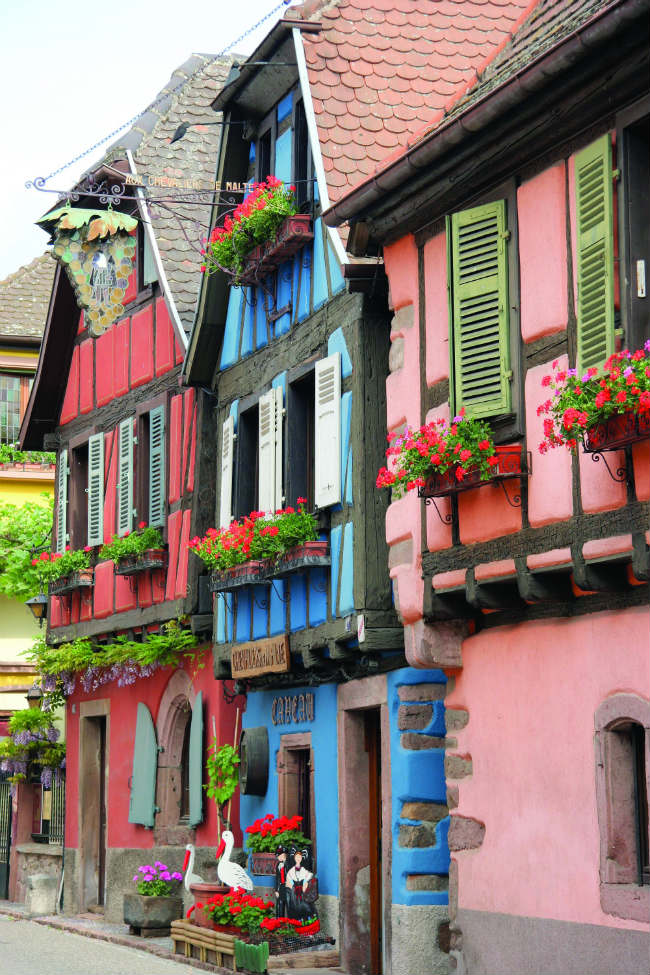
Traditional half-timbered buildings in Alsace. Photo: HECHT/ Conseil des Vins d’Alsace
Rich History
To continue exploring this rich vinous history, visit Colmar, the Alsatian wine capital. The Rhine has been a key artery of European commerce since time immemorial, and as early as the Middle Ages, Colmar sent wine from its tiny Horbourg-Wihr port far into northern and eastern Europe. And seeing the city from a boat gives a whole different perspective on Colmar, so hire a boat ride through the port and past the water-side half-timber houses in the delightful Little Venice neighbourhood. Later, one may visit the Musée Unterlinden in its remarkable new home or the so-called Maison des Têtes, a 1609 mansion in the heart of the historic old town, covered in sculpted heads and formerly home to the Alsace Bourse du Vin, or Wine Exchange. Today, La Maison des Têtes has been transformed into a luxury hotel and gourmet restaurant set around a beautiful medieval courtyard.
From Colmar, one may continue along the route de vin toward Mulhouse to discover its wines and rich industrial past. There’s the medieval Christmas market in Ribeauvillé, or the Alsace Ecomuseum in Ungersheim, a living history museum set in an authentic working village of 70 country houses with bakers, blacksmiths and potters. But after so much gastronomy and culture, there’s no better way to cap off an Alsatian vacation then to head west through the valley of Munster, up into the Vosges.
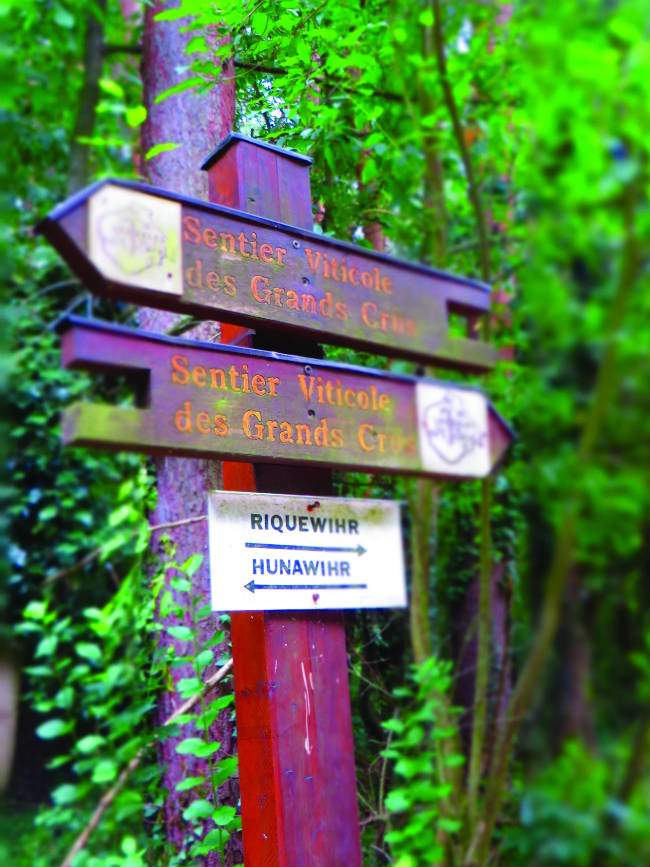
The Sentier Viticole des Grands Crus. Photo: Jeffrey T Iverson
In warmer months, there is fabulous hiking, rock climbing and paragliding, and in the winter, skiing, snowshoeing and other winter sports. When weather permits, perhaps the highlight of the Vosges is a simple drive along the breathtaking Route des Crêtes. This peak route was created along of the western side of the Vosges on the Alsace and Lorraine border during World War I, to obfuscate French troop movements from the German forces.
Surrounded by clouds, mountain lakes and valleys on either side, you can stop at a farm retreat like Auberge du Steinwasen for a hearty repas marcaire mountain meal, or just a slice of blueberry pie, coffee or kirsch. Finally, you can make your way up the 1,363-metre summit of Le Hohneck. There, looking out over the vast Alsatian plain, you may well agree with Louis XIV: Alsace truly is a beautiful garden.
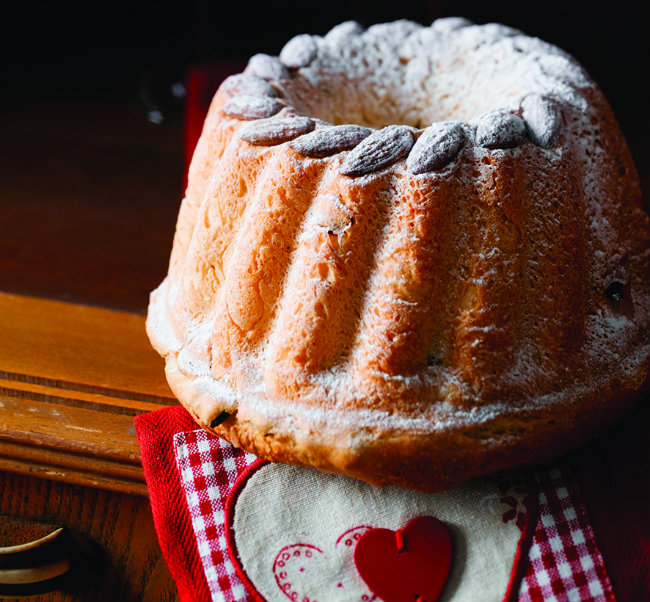
Kougelhopf. Photo: ELPEV/ Conseil des Vins d’Alsace
Alsace: A Gastronomic Melting Pot
Home to strong Munster cheese, foie gras, and spätzle egg noodles, Alsace’s rich gastronomy represents centuries of fertile fusion between German ingredients, global influences and French flair.
Choucroute or sauerkraut, the quintessential Alsatian dish of grated, pickled cabbage, prepared with white wine, salted meats and sausages or fish, can disappoint elsewhere, but in a true Alsatian winstub inn proves delicious.
Baeckeoffe, which translates as ‘baker’s oven’ in Alsatian, is a richly aromatic dish of sliced potatoes, onions, pork, lamb and beef which has been marinated in white wine and juniper berries, then slow cooked in a ceramic casserole dish.
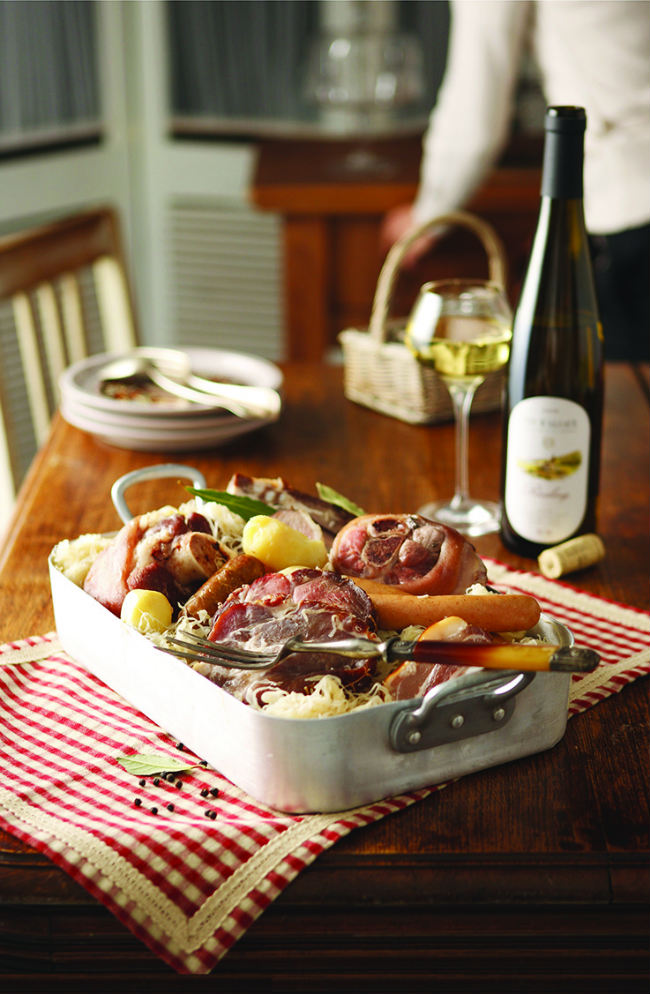
Choucroute. Photo: ELPEV/ Conseil des Vins d’Alsace
Flammekueche or tarte flambé, an ultra-thin pastry covered with cream, onions and lardons and cooked in a wood-fired oven, is Alsace’s most convivial dish, best shared, eaten like a crispy pizza, along with a nice, cold Alsatian beer.
Kokosmakronen (as they’re called in Alsace) or coconut macaroons, are traditionally found at Christmas markets, but these soft coconut cookies are a delight throughout the year, in every version: walnut, chocolate, even passion fruit…
Kougelhopf, a traditional moulded cake made of brioche dough, is an enduring symbol of Alsace. Sweet with raisins and almonds, it’s best enjoyed over breakfast or tea time, though savoury versions are also made, with bacon and walnuts.
From France Today magazine
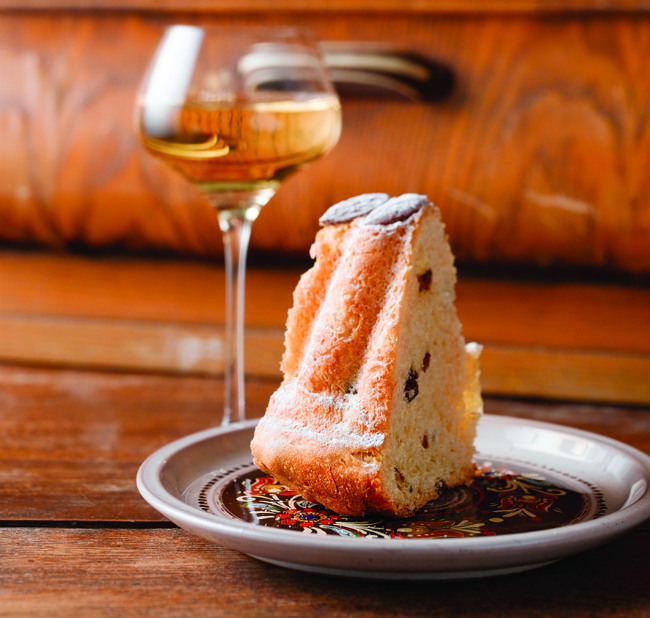
Kougelhopf. Photo: ELPEV/ Conseil des Vins d’Alsace
Share to: Facebook Twitter LinkedIn Email
Leave a reply
Your email address will not be published. Required fields are marked *



